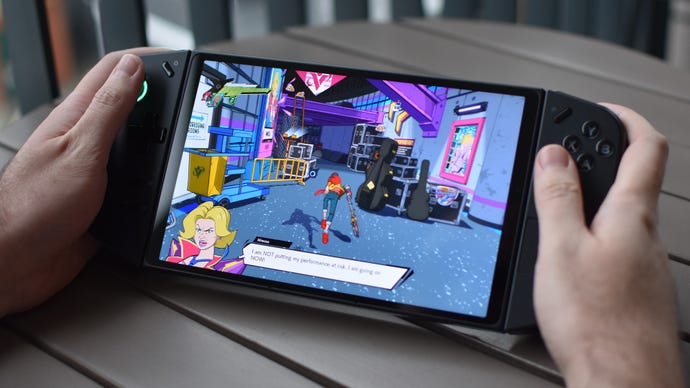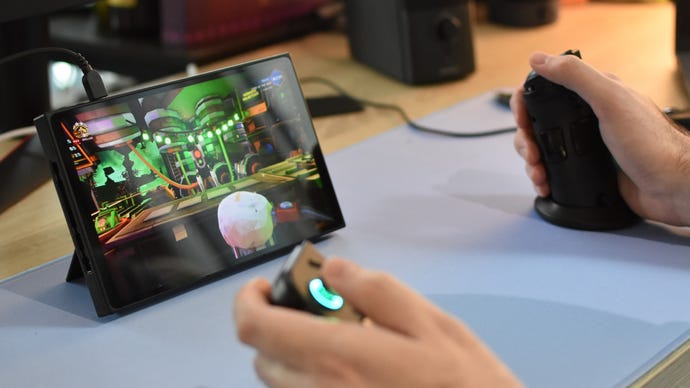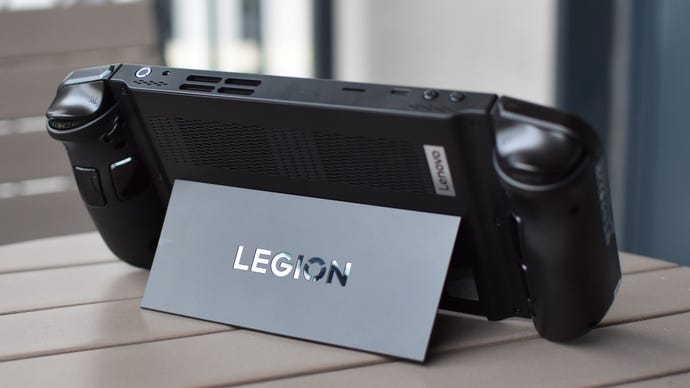Lenovo Legion Go review: a big handheld with bigger ideas
Detachable controllers and a massive screen ensure this is no half-cooked Steam Deck clone
It’s been encouraging to see how post-Steam Deck handheld PCs aren’t merely copying Valve’s homework. The Asus ROG Ally made a (mostly) successful attempt at slimming down while upping performance, and now we have the Lenovo Legion Go: an even higher-concept portable with Switch-style detachable controllers. One of which transforms into a mouse. It’s a bit mad but I’ve always loved the concept’s ambition, even as I rendered working protypes a little less... working.
I’m happy to report that this, the Legion Go’s retail version, is far more resistant to such improprieties. Moreover, it’s basically the best Windows handheld out there right now – though some occasional fiddliness, and the looming issue of the Steam Deck OLED, mean it isn’t necessarily the finest palmable PC outright.
There’s no arguing against it having some best-in-class specs. The centrepiece is that honking great 8.8in IPS touchscreen, which at 2560x1600 and with a 144Hz refresh rate, is more or less a proper gaming monitor that’s simply shrunk in the wash. It’s sharper and faster than both the Steam Deck OLED and Asus ROG Ally’s screens, and unlike both, the accompanying thumbsticks use a Hall Effect design that keeps them (theoretically) immune to dreaded stick drift. These don’t feel as substantial as the Deck’s relatively old-timey analog sticks, but they’re grippy enough for my lumbering thumbs.
Another big win over the ROG Ally is the inclusion of a trackpad. Just a little one, mind, not a full pair of big capacitive pads like you get on the Steam Deck, but it’s still enough to make navigating Windows 11 less miserable than it was on the Asus handheld. Same goes for the scroll wheel on the back of the right controller – not even the Steam Deck OLED has one of those.
What the Steam Deck does have – OLED or otherwise – is a somewhat better grasp of ergonomics. Although the Legion Go isn’t as heavy as it looks, neither is it as comfortably contoured as the Deck’s grips, and I could acutely feel the controllers’ severe edges pressing into my hands after a while. Especially on the right side, where the lowered thumbstick demands a more bottom-heavy grip. I also wish the rear buttons had a tad more resistance to them, as it seemed rather too easy to press them by accident while repositioning a sweaty/tired palm.
Still, it’s a tidy package overall. The controllers feel solid and secure when attached, and the matte plastic is of a higher grade than it was on the preview model I tested earlier this year. And, while the kickstand is more of a necessity than a handy bonus (given it’s essential for using the controllers in FPS mode), it’s plenty stable, with a nice, firm hinge. You even get a second USB-C port, doubling the amount that the Steam Deck and ROG Ally found room for. A dull spec? Not if you’re intended to plug peripherals and other accessories into your handheld PC.

The screen impresses as well. By covering 98.6% of the SRGB colour gamut, it’s actually capable of displaying a wider range of hues than even the Steam Deck OLED, so your most vibrant games will keep all of their visual pop. It’s mainly contrast and brightness where the Valve machine wins out, as it can reach 984cd/m2 in HDR mode; the Legion Go maxes out at 514cd/m2, though that’s still enough to punch through reflections on the glossy Gorilla Glass.
There’s no ghosting worth mentioning, and if you can get a game running fast enough to take advantage of the default 144Hz setting, then whacking such a high refresh rate on a battery-powered handheld starts making much more sense. There’s also an option to insta-switch to 60Hz, if you want to be more frugal, and the same quick-access menu also offers 1280x800 and 1920x1200 resolution toggles.
Admittedly, you will almost definitely need these. While it’s nice to have the option of running less APU-intensive fare at the full, beautifully crisp 1600p, the Legion Go’s AMD Ryzen Z1 Extreme chip all to often struggles under the weight of all those pixels. It usually takes a drop all the way down to 1280x800, same as the Steam Deck, to get smooth framerates even on low quality settings:
And these are just the games that could run adequately. Real tough’uns like Returnal and Starfield remain completely outside the Ryzen Z1 Extreme’s capabilities, even with 800p and FSR upscaling.
Again, when a game can run smoothly at 1600p, it’s great. Likewise for games like GTA V that can zoom past 100fps, a level of smoothness that’s unattainable on both the 60Hz Steam Deck and the 90Hz Steam Deck OLED. I’d say there’s an even stronger sensation of "Wowee, this is a PC game running on a handheld" than there is on the ROG Ally. And yet, just as with that device – which uses the exact same Ryzen Z1 Extreme APU – you can easily end up up having to switch off the Legion Go’s higher-end features in order to simply use it. That’s still strange, to me. It’s like buying a glistening new 4K monitor then hooking it up to a knackered GTX 960. Not only are you paying for specs you can’t always enjoy, but the lack of premium performance undermines the whole "You can play anything!" message that Windows-based handheld PCs are always keen to push.
In fairness, it is very nice to have all my Game Pass games playable locally, something that’s impossible on a Steam Deck without swapping out its entire OS. It’s also easy appreciate how installing launchers like Battle.net and the Epic Games Launcher only requires, y’know, an installer. Not diving so deep into SteamOS files that you come out with black lung. And, when you do need to traverse an undersized menu or dialogue box, it’s far more swiftly doable with the Legion Go’s trackpad than with the ROG Ally’s lack of one.

Not forgetting, of course, that the Legion Go offers another way of physically playing games entirely. One that’s both hugely distinct from other handhelds, and almost comfortingly familiar to seasoned desktop PC players. The two removable controllers may well be inspired by the Nintendo Switch, but they’re not for playing kart racers with a friend – they, or at least one of them, is for shifting into an upright mouse, complete with adjustable optical sensor (and that dinky scroll wheel). Hate aiming with thumbsticks in shooters? The Legion Go is so desperate to be the handheld for you that it’s willing to let you snap chunks off it in the process.
It initially feels quite odd, arguably more akin to an unsecured flight stick than a real vertical mouse. I got to grips with it eventually, though, and hey – when it works, it works. I was certainly more confident playing Team Fortress 2 or Deep Rock Galactic with the detached controller than I’ve ever been with a fixed thumbstick, or even the Deck’s purpose-built trackpads. I’m not saying to enter a Counter-Strike 2 tournament with it, but with an hour or so’s practice it is much closer to the feel of a standard gaming mouse than I previously would have expected from handheld hardware.

That said, it’s worth remembering where handheld PCs are mostly played: sofas, bus seats, metro trains, toilets. What all these have in common is a lack of any kind of stable, flat, smooth, adequately sized space on which to both set down the Legion Go and slide its mouse-controller around. Maybe an airline seat would work, but I certainly wouldn’t want to attempt twitchy FPS aiming on a tiny, flimsy, fold-out table. It’s hard to see where the reliable use case is, unless you want to be like the folks in the Legion Go’s launch trailer, misappropriating library tables and taking solo trips to cocktail bars.
Getting it set up is slightly faffy, too. Best case, you must set your Legion Go down, remove both controllers, put them down, pick the Legion Go back up, extend its kickstand, retrieve the controller base (which comes bundled but loose, a major misplacing hazard), slide the right controller inside it, flip the FPS mode switch, and finally pick up both controllers again to start playing. Now imagine doing all that on a wobbly train or in a packed Airbus where the sozzled scrum-half in adjacent seat already has his elbows halfway into your ribs. Not a pleasant thought, especially when you could leave the whole device as it is, and get playing immediately with thumbsticks.
If you don’t mind rebuilding your handheld, and think you can make it work on a regular basis, then by all means go ahead and enjoy FPS mode. Like I said, I admire the effort to make the Legion Go unique, and the practicality is there if you’re willing to do a little configuring yourself. That extends to the button mapping, too – for all but the simplest shooters, you’ll probably need to rebind some of the default inputs. I suppose I can’t help but think it’s still a pretty neat feature, even if I wouldn’t rely on it much myself.

Battery life also presents a couple of pleasant surprises. One, despite the bigger, faster, higher-resolution screen, the Legion Go is consistently longer-lasting than the ROG Ally. In Power Saving mode, with thermals and OS power both set to Balanced, it kept going for 2h 7m in GTA V and 2h 18in RimWorld; the ROG Ally only scored 1h 36m and 1h 45m respectively. Those were all on native resolution as well, so the 1080p ROG Ally had a built-in advantage over the 1600p Legion Go.
Granted, Valve’s handhelds are still top picks for longevity, especially in low-demand games like RimWorld: here, the original Steam Deck lasted for 5h 17m, and the more efficient Steam Deck OLED went all the way to 5h 42m. But the Legion Go pulled an upset in the altogether more demanding Forza Horizon 5, somehow pulling out 2h 00m dead. That bests not only the ROG Ally (1h 29m) but the Steam Deck (1h 37m) as well. It’s luck of the draw whether you get above or below average battery life, then, but bless it, the Legion Go evidently has an affinity with certain games. It charges mighty fast, too. Whereas an hour on the mains would let the Steam Deck reclaim 48% and the Steam Deck OLED 69%, the Legion Go nearly gets a full recharge, up to 96%.
You may be willing to accept shorter uptimes in exchange for the Legion Go’s wider game compatibility over the Steam Deck – a fair stance. Be warned, though, that as much as Windows 11 is a known quantity, its nonsense seems to be amplified when it’s been crowbarred into a handheld. It’s not as unwieldy as on the ROG Ally, thanks largely to that trackpad, but I still had to deal with wonkiness that simply isn’t present on the more tailor-made SteamOS. Newly installed games would often launch in the wrong windowed mode or aspect ratio, for example, or they’d open minimised for no apparent reason. The snap-to-edge system for windows on the desktop is also far, far too sensitive, squishing apps up against the screen’s sides when all I wanted to do was shift them a few centimetres. Disastrous? No, but you don’t get the it-just-works seamlessness of a Steam Deck.

Luckily for the Legion Go, it also sufficiently distinguish itself to the point that it never feels like a Steam Deck But Worse. If anything, it’s an Asus ROG Ally But Better: all the flexibility of Windows, with slightly fewer pain points, plus a sharper, faster screen, longer battery life, more connectivity, and a wider range of inputs. And even if its real-life applications are limited, the detachable mouse is good enough to fill a niche.
That’s why, for all the holes I’ve poked in it – and knowing I’m not going to ditch my Steam Deck OLED for it – I still like the Lenovo Legion Go. It gets enough of the basics right, and is ambitious enough with its specs and control scheme that the little annoyances (Windows acting up) and occasional overshoots (a max resolution that lots of games can’t use) become a lot more forgiveable. Or, at least, easier to look past.
This review is based on a retail unit provided by Lenovo.









